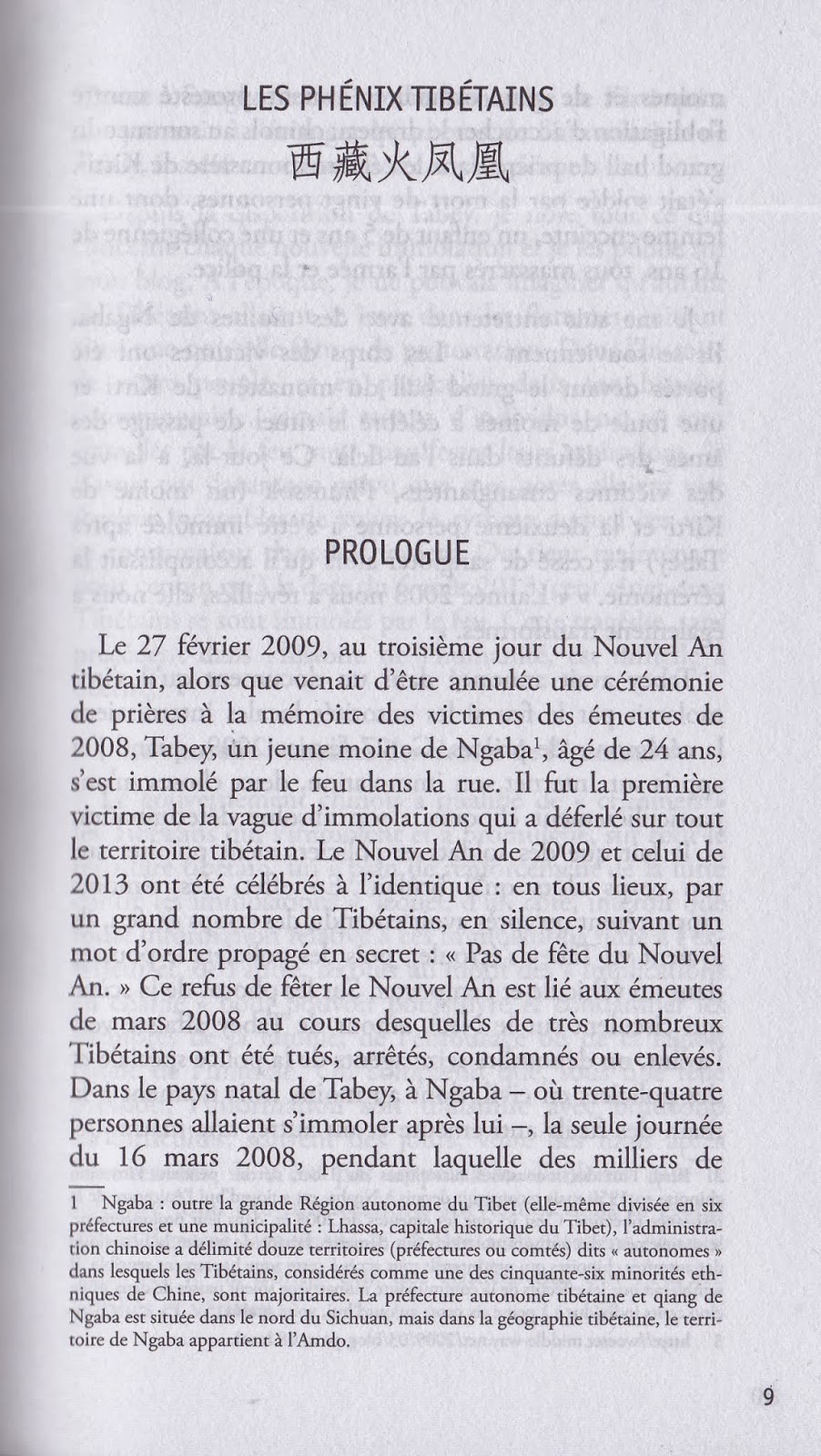此刻,我在拉萨。
始于今年四月的这本书——《Immolations in Tibet: The shame of the world》http://www.indigene-editions.fr/ceux-qui-marchent-contre-le-vent/immolations-au-tibet-la-honte-du-monde.html(我起的书名是《西藏火凤凰》Tibetan Phoenix),实际上心力交瘁地写作了两个月,虽然才两万多字。
在巴黎的出版社Indigène éditions关注藏人自焚,尤其关注如此众多的藏人自焚而世界却沉默的状况,希望通过我的文字向世界发声。
而这个出版社曾出版过《世界人权宣言》起草者之一、法国伟大的人权卫士、著名的社会活动家斯蒂凡纳·埃塞尔(Stéphane Hessel)先生著述的小册子《愤怒吧!》(Indignez-vous!) ,畅销全球,被译成35种文字包括中文。
 当我的这本新书完成之后,因为我在书中引述了同样是伟大的人权卫士、世界著名艺术家艾未未关于藏人自焚的一段评论——“西藏是拷问中国、国际社会人权和公正标准的最严厉问卷,没有人可以回避,可以绕过去。目前为止,没有人不受辱蒙羞。”——出版社希望请艾未未为这本关于藏人自焚的书设计封面,而艾未未当即给我回信说:
当我的这本新书完成之后,因为我在书中引述了同样是伟大的人权卫士、世界著名艺术家艾未未关于藏人自焚的一段评论——“西藏是拷问中国、国际社会人权和公正标准的最严厉问卷,没有人可以回避,可以绕过去。目前为止,没有人不受辱蒙羞。”——出版社希望请艾未未为这本关于藏人自焚的书设计封面,而艾未未当即给我回信说:“我愿意为藏人为你的文章的出版物做事。自焚行为的意义,无论从哲学还是宗教层面,它超越了尚存者的任何试图理解和诉说的努力,人们看到仅是它发生的直接的政治原因。。我还是愿意试一试,尽管我十分明确这有多让人绝望。。”
而在有着重要意义的封面设计——所有自焚藏人的名字用藏文记录其上;中间的一朵火焰壮丽,充满奉献的美而非惨烈的苦;洁净的封面宛如西藏洁白的哈达,以献给所有自焚藏人——完成之后,艾未未在给我的邮件中写到:“……比较挣扎,想用一种较为平静的方式来看待牺牲的西藏的逝者。勇气、精神、记忆、和我无知的层面。。。诸多因素。”
在此,特别感谢艾未未!
还要感谢的是,为我的这有关藏人自焚的新书撰写序言的Robert Badinter(罗贝尔·巴丹戴尔)先生,据维基百科介绍,他是法国律师、教授、随笔作家以及法国的政治家。事实上,他被称为法兰西“废除死刑之父”。

在出版社的网站上,我读到罗贝尔·巴丹戴尔先生对藏人自焚的评论:
« Voici un livre dense et tragique », écrit dans sa préface Robert Badinter. Il poursuit : « Ce que les flammes qui les brûlent proclament, c’est qu’ils ne peuvent plus supporter l’agression commise contre leur peuple, l’éradication de ses coutumes et de sa langue, le génocide culturel auxquels, dans le lâche silence des États, les autorités chinoises se livrent au Tibet. »
我还要感谢友人、创办High Peaks Pure Earth(高峰净土)网站的Dechen Pemba,她一直在为我和巴黎的出版社之间承担不可替代的联系,并为我发来了这本新书的照片。
需要说明的是,上个月在台湾,我编著的《自焚藏人档案》由雪域出版社出版。但这本中文书与今天在法国发行的法文书《Immolations in Tibet: The shame of the world》不同。中文书是一本20多万字的记录之书,并收录有近两百幅照片,主要是对每一位自焚藏人生平的记录、回忆,及中共当局的相关政策的转载,等等。
而法文书《Immolations in Tibet: The shame of the world》的意义在于竭力的解释、沉痛的分析和直率的批评。这是章节目录:
开篇
藏人自焚概况
自焚是一种抗议
藏人为何抗议
抗议为何走向自焚
从两个高峰看自焚诉求
自焚者的遗言
自焚如何被记录
抗议需要得到支持
中国当局对自焚者的污名化
“逆向种族隔离”的拉萨
中国当局的“反自焚运动”
休戚与共的迢迢长路
结语
最后,转录这本法文新书的结语如下:
许多个白天或黑夜,我在电脑上一张张地看着自焚族人的照片,看他们生前充满活力的照片,看他们被火焰吞噬壮烈殉难的照片,每个人都是拥有西藏谚语推崇的“心脏的骨头”(སྙིང་རུས།)。我觉得他们都很面熟,彷佛我去过他们的家乡和寺院,在路上与他们相遇、微笑……是的,绝大多数地方我都去过,其中还有我的生长之地,因此我认为自己有责任为之记录:说出这一切,说出每一位自焚族人的故事,以及不能忘却的记忆。
是的,“心脏的骨头”既是谚语也是隐喻。以身浴火的英雄儿女,全都属于深藏在雪域高原内部的“心脏的骨头”,劫难中的西藏因此而不亡。然而以自焚表达抗议太惨烈,太痛苦,为此我曾发出呼吁,请求藏人不再自焚,压迫再大也要留住生命。但我们的呼吁无效,实际上我也清楚必然如此。一方面,这种自焚运动如同地震或洪水那样,不是谁赞成与否就可以左右的,需要把所有的能量全部释放才可能消退。更关键的是,受命于当局的官员与军警仍然在西藏到处作恶点火,唯有当其不再作恶点火,藏人才有可能顾及、保全个人的生命。
一切的记忆都与苦难的火焰有关,唯有我们真正的怀念、铭记和坚持,才有可能让火焰中的牺牲者,在每一天回到我们中间,在每一天回到这被称为“岗炯(雪域)”的广大土地上,永远在场,永远生生不息……容我双手合十,向自焚的族人们致以最痛的祈祷,以及最高的景仰!
附:法新社(AFP)今日报道
By Marianne Barriaux (AFP)
Paris — A blogger, a taxi driver, a Communist Party official and a Buddhist monk. All of them Tibetan, and all of them driven to the desperate step of setting themselves on fire in protest at Chinese rule.
These and dozens of others are the subject of a new booklet written by Tsering Woeser, a famous Tibetan poet, essayist and fierce critic of the Chinese government's rule over the sprawling Himalayan region.
"Immolations in Tibet: The shame of the world" -- which so far is only being published in French and will be released in Paris on Thursday -- is illustrated by Chinese dissident artist Ai Weiwei.
In it, Woeser -- who lives under surveillance in Beijing but has an extensive network of contacts in Tibetan areas -- tries to get to the root of why at least 120 Tibetans have set themselves alight in recent years, most in China but some outside the country. Many, but not all, have died.
"Hunger strikes are a method of protest universally accepted and respected, whilst self-immolation is often ignored, because such suffering goes beyond the limits of what most people can conceive, even in their imagination," she writes.
"Self-immolation is the most hard-hitting thing that these isolated protesters can do while still respecting principles of non-violence."
The first recorded self-immolation in China was in February 2009, but Tibetan areas have seen an explosion in this violent form of protest since March 2011 when a monk set himself on fire at the revered Kirti monastery and died, sparking riots.
Beijing has always strongly condemned the acts and blames them on exiled Tibetan leader the Dalai Lama, saying he uses them to further a separatist agenda. It maintains that Chinese rule has brought development and riches to the plateau.
But Tibetans say the self-immolations are a response to increasing curbs on their religious and political freedoms, particularly since deadly 2008 riots in the Tibetan capital Lhasa that spread to neighbouring areas.
In the booklet, Woeser describes Tibetan regions as a "giant prison criss-crossed with armed soldiers and armoured vehicles".
The reasons behind the protests, she adds, are diverse -- authorities arresting people for watching videos of the Dalai Lama's teachings, nomads forced off their pasture land to make way for mines and dams, surveillance cameras in monasteries, and many more.
"They think we're scared of military repression, they're wrong" said Tenzin Phuntsok, one of the victims whose last words were cited in the booklet.
And while monks and nuns were the first to set themselves on fire, a growing number of laypeople have started using this desperate, last-ditch form of protest.
She cites "two schoolgirls, three students, three workers, four retailers, one carpenter, a blogger, a tangka (traditional Tibetan painting) artist, a taxi driver, a retired Communist Party official."
One 25-year-old farmer called Wangchen Norbu, Woeser says, went specifically to a photo studio to have his picture taken before he self-immolated.
Woeser, whose father was an army officer from China's majority Han ethnic group and whose mother was a Tibetan Communist official, is widely known among Tibetans for her blog -- translated into English on www.highpeakspureearth.com -- as well as poems and essays.
As a result, she is under intense police scrutiny but unlike some other activists has so far avoided arrest and is still relatively free to move around the country.
But Woeser, who is in her late 40s, admits that a booklet published abroad could get her into trouble with Chinese authorities.
"For a long time, I have felt like I'm at the edge of a precipice, and I could fall at any time," she told AFP by email from her hometown of Lhasa, where she has been staying since June.
"And writing this kind of book... is definitely dangerous. But I don't yet know how dangerous."
"I'm closely watched every day, 24 hours a day," she added, pointing out that three to four cars full of plainclothes policemen are parked in front of her compound daily, a camera sits on her flat's roof, and security officers follow her every steps.
"As for when I'm in Beijing, just this year I've been put under house arrest three times, which put together lasted more than a month."
from 看不见的西藏~唯色 http://woeser.middle-way.net/2013/10/immolations-in-tibet-shame-of-world.html

